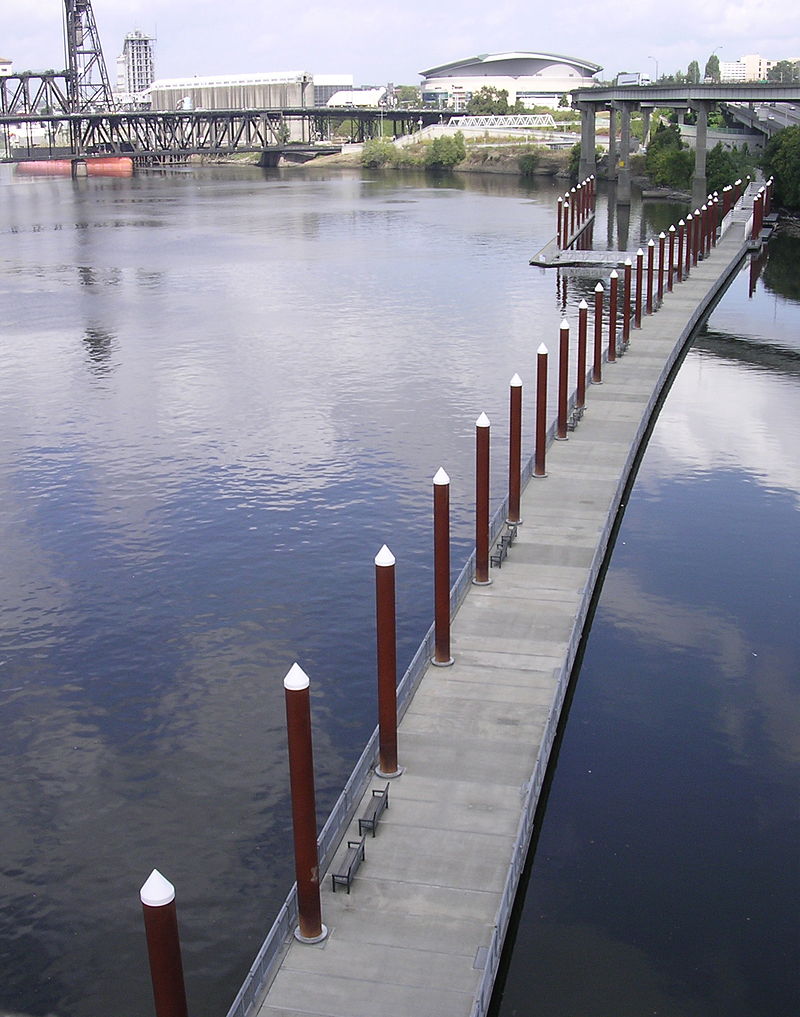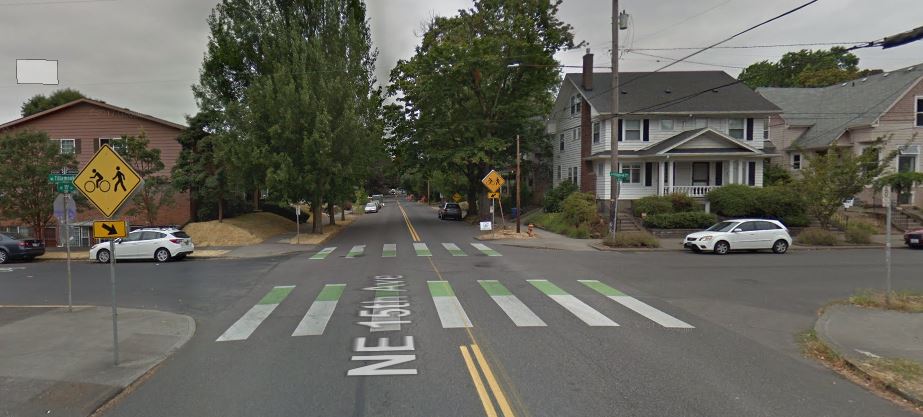On January 4th, 2019—less than a week ago—a pedestrian here in Portland was killed by a motor vehicle while crossing the street at the intersection of SW Salmon and Park. This intersection only features one marked crosswalk. According to the statement released by police, the pedestrian was in an “unmarked crosswalk” when he was hit.
Category Archives: Portland

E-Bikes And E-Scooters On The Springwater, Esplanade And Other Portland Parks
The recent prevalence of e-bikes on Portland streets, and the even more recent influx of e-scooters, has increased the public’s curiosity about state and local law governing the devices. Many Portlanders now know that e-bikes and e-scooters are prohibited on sidewalks statewide, users of both must be at least 16 years old, and e-scooter users must wear helmets, but not e-bike riders. (For a comprehensive look at Oregon e-bike law, see our firm’s legal guide here.) A lesser known provision of Portland city code came to my attention recently in an article by the Oregonian’s Lizzy Acker, which included the following statement:
I emailed Portland Bureau of Transportation spokesperson John Brady on Friday to ask him some question about the scooters and he informed me that city code does not allow scooters in city parks, including the esplanade and the Springwater Corridor, so I can’t recommend you take this route home.
Cynthia Newton’s Back to School Road Safety Tips
TCNF Partner Cynthia Newton spoke with KATU traffic reporter Hannah Olsen about getting your kids to school safely by bike. In this clip, aired in Portland on August 27th, 2018, Cynthia explains her five rules for safe bike travel to school.
1. Find a good route from where you live to your school. That way you can follow the same route every day. No fuss. No rush.
2. You can ride on the sidewalk everywhere in PDX except downtown. Remember to slow to a walking speed when crossing driveways and entering crosswalks so cars have more time to see you.
3. When crossing the street, always use a crosswalk. There is a crosswalk at every corner, even if there is no paint on the roadway. Enter at walking speed so cars have more time to see you.
4. Kids under 16 are required to wear a helmet. Kids are more likely to wear a helmet if their parent does.
5. Wear white and use a light. Lights—a white one in front and a red one in rear—are required in limited visibility conditions, but wearing white or using a light anytime makes you more visible. Drivers don’t hit cyclists they can see.
KATU’s article about this conversation with Cynthia, including some additional advice from TCNF attorney Chris Thomas, can be found here.
We’re fans of BIKETOWN, but its Rules of the Road need work – Chris Thomas
BIKETOWN, Portland’s bike sharing system, is a great resource for getting more people on bikes. The system’s efforts to encourage more riding include educating users about how to ride properly and without violating Oregon law. However, some of BIKETOWN’s advice incorrectly describes Oregon law and has the potential to mislead bicyclists who are learning the ropes.
SIDEWALKS
Printed on each BIKETOWN bike is a list of riding tips, which includes “WALK BIKES ON SIDEWALK”:

The BIKETOWN website contains a section entitled Rules of the Road, which advises bicyclists “AVOID SIDEWALKS” and “. . . whenever possible, it’s best to ride on the road and leave the sidewalk for pedestrian traffic.”

In fact, Oregon law generally allows bicyclists to ride on the sidewalk, provided they comply with the requirements of ORS 814.410, including obligations to yield to pedestrians, audibly warn before passing, and enter crosswalks at a walking speed. Many local jurisdictions impose prohibitions on riding in downtown core areas, including Portland, where bicyclists generally may not ride on the sidewalk between Naito Parkway, 13th Avenue, SW Jefferson and NW Hoyt. Portland City Code 16.70.320. Although BIKETOWN’s warnings about sidewalk riding may apply in Portland’s downtown core, that area constitutes a small fraction of the system’s service area, which includes many high speed thoroughfares without bike lanes, such as NE Sandy, SE Powell and NE Martin Luther King. In those places, a bicyclist may feel safer riding on the sidewalk than in the roadway, and they would be legally entitled to do so.
HEADPHONES
The Rules of the Road section of the BIKETOWN website also states: “It is also illegal to ride with two headphones in; one is permitted, but it’s always safer to ride without any.”

This is a clear misstatement of Oregon law. Without wading into the prudence of riding with headphones, no section of the Oregon vehicle code explicitly prohibits such use (in one ear or both). California law does include such a prohibition, which likely caused the confusion here, but given that BIKETOWN exclusively operates in Oregon, this is an incorrect statement of the law.
We think it is important to clearly state which parts of BIKETOWN’s advice is based on Oregon law, and which parts are put forth as safe riding “tips.”
In the meantime, check out TCNF’s pocket sized cards that summarize Oregon bike law, which can be found here and at local bike shops.
What is the legal significance of “crossbikes” on neighborhood greenways? – Chris Thomas
Portland’s inner eastside contains an extensive network of neighborhood greenways: low traffic side streets that encourage bike traffic by including sharrow pavement markings, bike-specific wayfinding signs, speed bumps, diverters, and fewer stop signs. Examples include NE Going, NE Tillamook, SE Clinton and SE Lincoln. While greenway riding is typically a low key alternative to riding in a bike lane or on the shoulder of high-volume, auto-oriented streets, the crossing of higher speed arterials that cross the greenway can be stressful. At most greenway crossings of arterials, bicyclists face a stop sign and cross traffic flows freely. In an effort to improve arterial crossings, the City has painted green “crossbikes” across the intersection and installed signs warning arterial drivers of the greenway crossing. The NE Tillamook greenway crossing of NE 15th Avenue is shown here:

What, if any, legal authority do these green “crossbikes” confer on greenway bike users? The short answer: none. Despite the similarity in appearance and name to “crosswalk”, a crossbike does not entitle a bicyclist to any of the legal rights enjoyed by a crosswalk user.
Crossbikes do not fall under the legal definition of a crosswalk. A marked crosswalk is defined under ORS 801.220 as “any portion of a roadway at an intersection or elsewhere that is distinctly indicated for pedestrian crossing by lines or other markings on the surface of the roadway.” While crossbikes do constitute roadway markings at an intersection, their location in the roadway demonstrates that they are not intended for “pedestrian crossing.” Therefore, crossbikes are not crosswalks, and crossbike users are not entitled to any of the legal rights of crosswalk users. In fact, crossbikes fail to fall within any statutory definition under Oregon law, making them legally meaningless.
Despite their lack of legal meaning, drivers and bicyclists often treat crossbikes as if they were—as their name suggests—crosswalks for bikes. Under Oregon’s crosswalk law, ORS 811.028, once a pedestrian begins crossing in a crosswalk, approaching drivers must stop and remain stopped until the pedestrian has cleared. Pedestrians can assert this right of way by moving into the roadway with the intent to proceed. Therefore, pedestrians using the white zebra-striped crosswalks in the above photo have the legal right to cause cross traffic to stop simply by stepping into the roadway.
In contrast, bicycle users of the green zebra-striped crossbikes in the above photo have no right to cause cross traffic to stop. Instead, pursuant to ORS 811.260(15), the stop sign they face requires them to stop and yield to cross traffic. However, the similar appearance of the two types of markings, together with the yellow signs indicating bicycle and pedestrian crossing, strongly suggests that arterial traffic must yield to all greenway users. Indeed, the behavior of many arterial drivers and greenway bicyclists demonstrates that, despite the underlying legal rights, crossbikes largely function as crosswalks for practical purposes.
Is there any harm in this inconsistency between the practical use of infrastructure and the underlying legal authority? In many cases, perhaps not. While installing crossbikes didn’t cost the City much (the green paint and signs were presumably relatively inexpensive) and the legal ambiguity may help bicyclists cross arterials more efficiently, there may be higher costs. For example, what if a bicyclist mistakenly assumes that an approaching vehicle is slowing, and rolls past the stop sign into the crossbike? Under Oregon law, the driver would clearly have the right of way, and the result could be a seriously injured bicyclist with no legal recourse because the cyclist was not entitled to the right of way.
